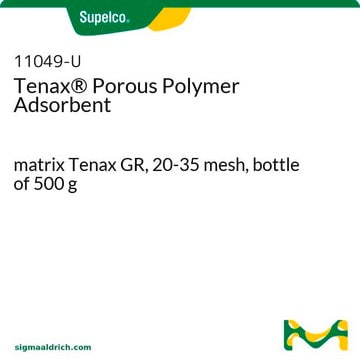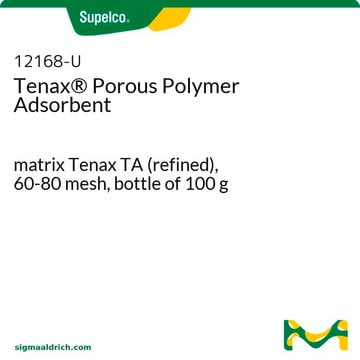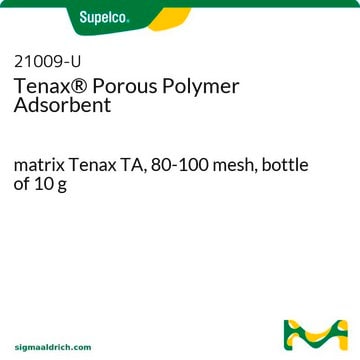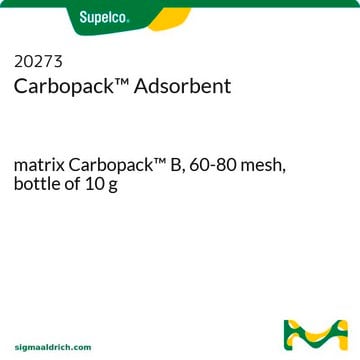Products may be shipped at a different temperature than the recommended long-term storage temperature. If the product quality is sensitive to short-term exposure to conditions other than the recommended long-term storage, it will be shipped on wet or dry-ice. If the product quality is NOT affected by short-term exposure to conditions other than the recommended long-term storage, it will be shipped at ambient temperature. As shipping routes are configured for minimum transit times, shipping at ambient temperature helps control shipping costs for our customers. For more information, please refer to the Storage and Transport Conditions document: https://www.sigmaaldrich.com/deepweb/assets/sigmaaldrich/marketing/global/documents/316/622/storage-transport-conditions-mk.pdf
11982
Adsorbente de polímero poroso TENAX®
matrix Tenax TA, 60-80 mesh, bottle of 10g
Seleccione un Tamaño
Seleccione un Tamaño
About This Item
Productos recomendados
Nombre del producto
Adsorbente de polímero poroso TENAX®, matrix Tenax TA, 60-80 mesh, bottle of 10 g
Agency
suitable for EPA 601
Nivel de calidad
Formulario
solid
envase
bottle of 10 g
Parámetros
350 °C temp. limit
superficie
~35 m2/g
Matriz
Tenax TA
tamaño de partícula
60-80 mesh
densidad
~0.25 g/mL (free fall density)
¿Está buscando productos similares? Visita Guía de comparación de productos
Categorías relacionadas
Descripción general
Para obtener más información acerca de cualquiera de nuestros adsorbentes, visite sigma-aldrich.com/adsorbents
Aplicación
- Compuestos orgánicos volátiles (VOC) en diferentes microentornos antes de su determinación mediante desorción térmica de paso corto (SPTD) y cromatografía de gases-espectrometría de masas (GC-MS).[1]
- Hidrocarburos C 7-C26 en muestras de aire ambiente[2] y VOC en muestras de aire de la sala de trabajo[3] antes de su análisis por TD seguido de análisis por GC.
Información legal
Palabra de señalización
Warning
Frases de peligro
Consejos de prudencia
Clasificaciones de peligro
Eye Irrit. 2 - Skin Irrit. 2 - STOT SE 3
Órganos de actuación
Respiratory system
Código de clase de almacenamiento
11 - Combustible Solids
Clase de riesgo para el agua (WGK)
WGK 3
Punto de inflamabilidad (°F)
Not applicable
Punto de inflamabilidad (°C)
Not applicable
Equipo de protección personal
dust mask type N95 (US), Eyeshields, Gloves
Elija entre una de las versiones más recientes:
Certificados de análisis (COA)
It looks like we've run into a problem, but you can still download Certificates of Analysis from our Documentos section.
Si necesita más asistencia, póngase en contacto con Atención al cliente
¿Ya tiene este producto?
Encuentre la documentación para los productos que ha comprado recientemente en la Biblioteca de documentos.
Los clientes también vieron
Contenido relacionado
This page is intended to make it easier to find the consumables you need based on the analytical method you’re using. Methods included on this page come from the EPA, Standard Methods and ASTM.
-
How is shipping temperature determined? And how is it related to the product storage temperature?
1 answer-
Helpful?
-
-
How can I determine the shelf life / expiration / retest date of this product?
1 answer-
If this product has an expiration or retest date, it will be shown on the Certificate of Analysis (COA, CofA). If there is no retest or expiration date listed on the product's COA, we do not have suitable stability data to determine a shelf life. For these products, the only date on the COA will be the release date; a retest, expiration, or use-by-date will not be displayed.
For all products, we recommend handling per defined conditions as printed in our product literature and website product descriptions. We recommend that products should be routinely inspected by customers to ensure they perform as expected.
For products without retest or expiration dates, our standard warranty of 1 year from the date of shipment is applicable.
For more information, please refer to the Product Dating Information document: https://www.sigmaaldrich.com/deepweb/assets/sigmaaldrich/marketing/global/documents/449/386/product-dating-information-mk.pdfHelpful?
-
-
Can tenax be restored in laboratory oven at 40 *C temperature?
1 answer-
The Tenax® Porous Polymer Adsorbent can be regenerated by hot-methanol extraction.
Helpful?
-
-
What is the Department of Transportation shipping information for this product?
1 answer-
Transportation information can be found in Section 14 of the product's (M)SDS.To access the shipping information for this material, use the link on the product detail page for the product.
Helpful?
-
-
What solvents can be used for chemical desorption for Product No. 11982, Tenax TA 60-80 mesh?
1 answer-
Common solvents like alcohols, ethers, hydrocarbons, and aqueous hydrochloric acid/sodium hydroxide can be used. Don't use chlorinated hydrocarbons like dichloromethane, aromatics like xylene and carbon disulfide. All other solvents not mentioned can be used after checking solubility.
Helpful?
-
Active Filters
Nuestro equipo de científicos tiene experiencia en todas las áreas de investigación: Ciencias de la vida, Ciencia de los materiales, Síntesis química, Cromatografía, Analítica y muchas otras.
Póngase en contacto con el Servicio técnico











